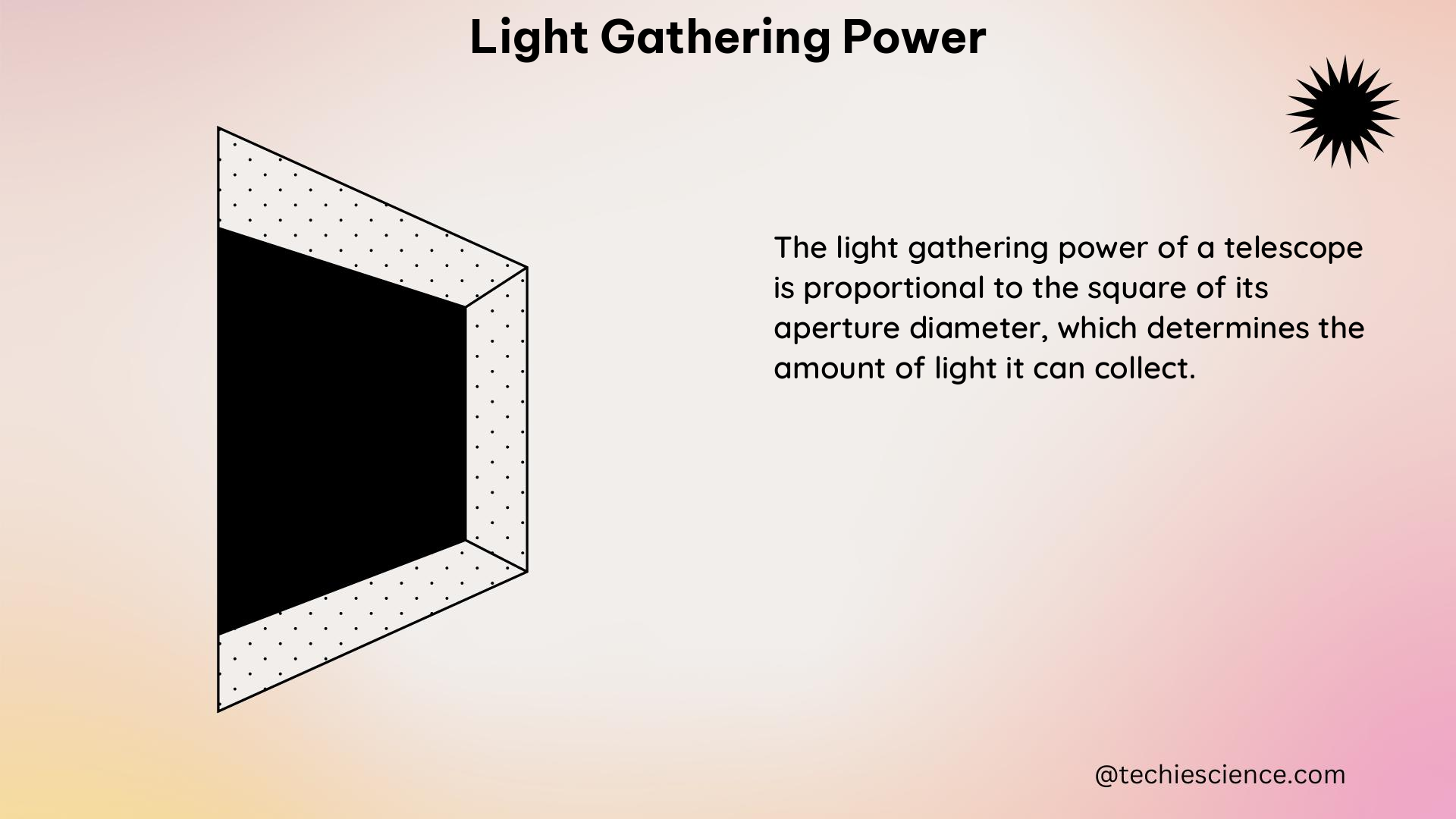The light gathering power of a telescope is a crucial parameter that determines its ability to observe faint celestial objects. This metric is directly proportional to the area of the telescope’s objective lens or primary mirror, allowing larger instruments to collect more light and reveal the intricate details of distant galaxies, nebulae, and stars.
Understanding the Fundamentals of Light Gathering Power
The light gathering power of a telescope can be calculated using the following formula:
Light Gathering Power = (Diameter of Objective Lens or Primary Mirror)^2 / (Diameter of Human Pupil)^2
This equation demonstrates that the light gathering power is directly proportional to the square of the telescope’s objective lens or primary mirror diameter. In other words, doubling the diameter of the lens or mirror will result in a four-fold increase in the light gathering power.
Comparing Light Gathering Power of Different Telescopes
Let’s explore the light gathering power of some renowned telescopes:
| Telescope | Objective Lens/Mirror Diameter | Light Gathering Power |
|---|---|---|
| Gemini Telescope | 8000 mm | 1,000,000 times the human eye |
| Largest Telescope at Reimers Observatory | 635 mm | 6,300 times the human eye |
| Funscope Telescope | 76 mm | 90 times the human eye |
These examples illustrate the significant advantage of larger telescopes in terms of their ability to collect and concentrate light, enabling the observation of fainter and more distant celestial objects.
Importance of Light Gathering Power in Astronomical Observations

The light gathering power of a telescope is crucial for several reasons:
-
Observing Faint Objects: By collecting more light, telescopes with higher light gathering power can detect and study faint objects, such as distant galaxies, nebulae, and stars, that would otherwise be invisible to the human eye or smaller telescopes.
-
Detailed Observations: The increased light gathering power allows for more detailed observations of the observed objects, enabling astronomers to study their properties and characteristics in greater depth.
-
Resolving Power: In addition to light gathering power, the resolving power of a telescope is also important for distinguishing between two points in the sky. The resolving power is calculated using the formula:
Resolving Power = 11.25 seconds of arc / Diameter of Objective Lens or Primary Mirror
This means that a larger objective lens or primary mirror will result in a higher resolving power, allowing for the observation of finer details in the observed objects.
Practical Applications of Light Gathering Power
The light gathering power of a telescope has numerous practical applications in the field of astronomy:
-
Extragalactic Astronomy: Telescopes with high light gathering power are essential for studying distant galaxies, providing insights into the structure, evolution, and properties of these cosmic structures.
-
Stellar Astrophysics: The increased light gathering power enables detailed observations of stars, allowing astronomers to analyze their composition, temperature, and other physical characteristics.
-
Planetary Observations: Larger telescopes can provide high-resolution images of planets within our solar system, enabling the study of their atmospheric dynamics, surface features, and potential signs of extraterrestrial life.
-
Spectroscopy: The light gathering power of a telescope is crucial for spectroscopic analysis, which involves the study of the absorption and emission spectra of celestial objects. This technique provides valuable information about the chemical composition and physical properties of these objects.
Advancements in Light Gathering Power
The quest for ever-increasing light gathering power has driven the development of larger and more sophisticated telescopes. Some notable advancements include:
-
Segmented Mirror Telescopes: These telescopes, such as the James Webb Space Telescope, use a mosaic of smaller mirror segments to create a large primary mirror, allowing for the construction of extremely large telescopes.
-
Adaptive Optics: This technology compensates for the distortion caused by the Earth’s atmosphere, improving the resolving power and light gathering efficiency of ground-based telescopes.
-
Interferometry: By combining the light-gathering power of multiple telescopes, interferometric techniques can achieve the equivalent of a single telescope with a much larger effective aperture.
-
Space-based Telescopes: Telescopes operating in space, such as the Hubble Space Telescope, are not limited by the Earth’s atmosphere, allowing for unparalleled light gathering power and resolving power.
Conclusion
The light gathering power of a telescope is a fundamental parameter that determines its ability to observe and study faint and distant celestial objects. By understanding the principles and practical applications of this concept, astronomers and astrophysicists can leverage the power of larger telescopes to push the boundaries of our knowledge about the universe.
References:
– How To Present Quantitative & Qualitative Data Together In Reporting
– Light Gathering, Resolution – Telescope – Britannica
– Compare the light-gathering power of the Palomar Observatory’s 5
– Qualitative and quantitative measurements: a balanced approach
– Light Gathering Power of Telescopes | Starry Sky Austin

The lambdageeks.com Core SME Team is a group of experienced subject matter experts from diverse scientific and technical fields including Physics, Chemistry, Technology,Electronics & Electrical Engineering, Automotive, Mechanical Engineering. Our team collaborates to create high-quality, well-researched articles on a wide range of science and technology topics for the lambdageeks.com website.
All Our Senior SME are having more than 7 Years of experience in the respective fields . They are either Working Industry Professionals or assocaited With different Universities. Refer Our Authors Page to get to know About our Core SMEs.